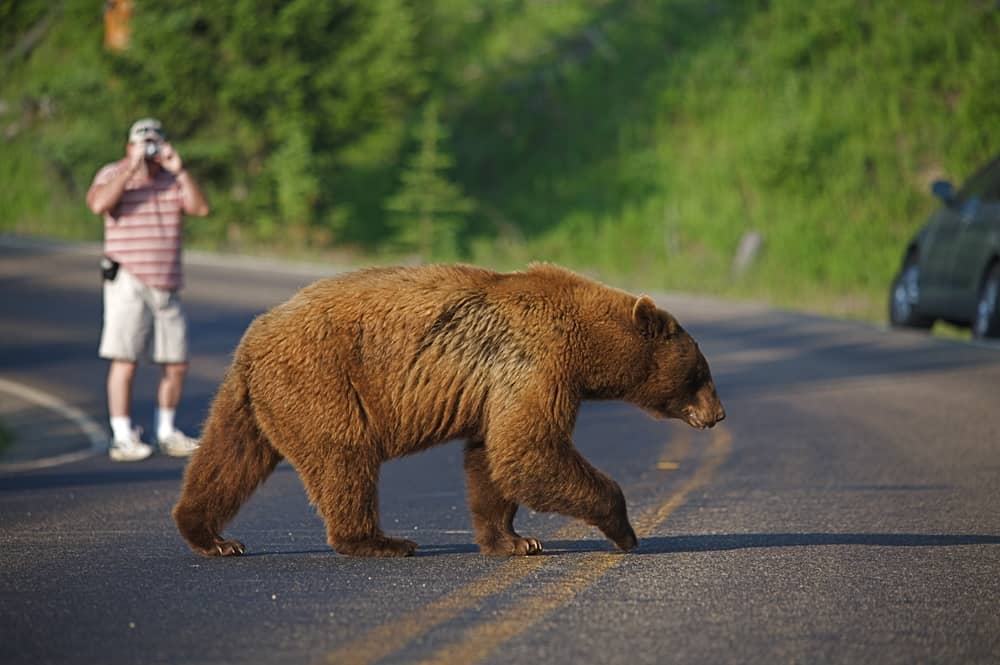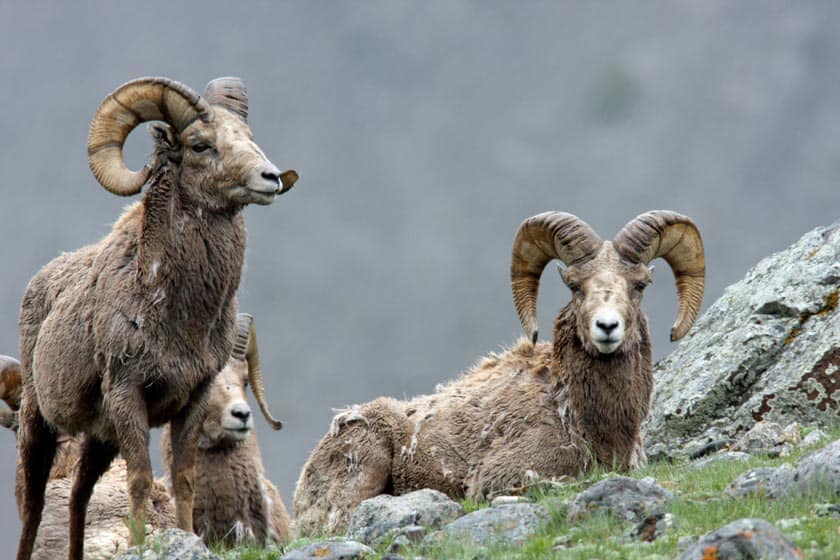There are so many things to do and see in Yellowstone that a multi-day itinerary is necessary to enjoy them fully: with geysers, hot pools, fumaroles, valleys, and waterfalls, you’ll be spoilt for choice, but Mother Nature has been so generous in this area to give us another gift, one of the most extraordinary and rich fauna in North America.
What animals live in Yellowstone National Park? Yellowstone wildlife includes bears, moose, wolves, bison, elks, deer, eagles, pronghorn, swans and more… and the nearby Grand Teton National Park is no less so. Many animals can be spotted “by chance”, when meandering by car on the main roads (this is the case for bison in Yellowstone) while others require some more effort and you may not always be so lucky to spot them. In this article, I would like to give you some tips on the best places to see wildlife in Yellowstone and Grand Teton, while always paying due attention and taking the necessary precautions. Let’s see briefly what they are:
Contents
Yellowstone Wildlife: Safety Tips

Obviously, some of the animals you will see are dangerous, so you need to be careful and take proper precautions. Here are some general Yellowstone Park tips for dealing with local wildlife:
“Yellowstone’s animals are wild and unpredictable, even as calm as they seem. The safest way to see them (and often the best) is from inside your car. Always stay at least 100 yards away from bears and wolves and at least 27 yards away from all other animals, including bison and elk.”
Below are some signs you will often find in Yellowstone:
Also, avoid feeding animals by taking care to store food and trash tightly closed so as not to attract local wildlife. I also recommend that you read the guidelines on the official website about bears, to be taken into even greater consideration if your visit includes long excursions in areas that are not so heavily populated by tourists. As far as general safety warnings and attitudes towards other animals are concerned, you will find everything on this page.
Where to See Wildlife in Yellowstone and Grand Teton?
Let’s take a look at the best places to see wildlife in Yellowstone and Grand Teton:
Where to See Bears (American black bear)
The bear is certainly not an uncommon animal in Yellowstone. Official data reports as many as 37,000 sightings between 1980 and 2005. American black bears can weigh up to 400 pounds, and because of their size, they can often be confused with larger grizzly bears. Here’s where you can see them:
- In Yellowstone: look for them primarily in Lamar Valley, Hayden Valley, and along the roads between Elk Creek and Tower Falls, and between Mammoth Hot Springs and Indian Creek.
- In Grand Teton: look for them at Two Ocean and Emma Mathilde lakes, in the Colter Bay area, and on the Teton Park Road.
Where to See Grizzly Bears
Known as “brown bears,” they are distinguished from other Yellowstone bears not so much by their color (there are also brown-colored black bears) but by their size (they can weigh up to 700 pounds), peculiar hump, longer snout, and smaller ears. Grizzly bears are often active during the night and at twilight. The advice is to try to spot them with binoculars in the park grasslands just after sunrise and just before sunset. Here’s where to go to look for them:
- In Yellowstone: in addition to Lamar Valley or Hayden Valley you can also look for them in Pelican Valley (near the northern shores of Lake Yellowstone), in Yellowstone Lake itself, and near Heart Lake. Grizzly bear sightings are also reported at Swan Lake Flats, Gardiners Hole (both of which are south of Mammoth Hot Springs), Dunraven Pass (near Mount Washburn, north of the Grand Canyon of Yellowstone), on the north side of Mount Washburn, and in the wetlands along East Entrance Road, on the wide stretch from Fishing Bridge to the park’s east entrance.
- In Grand Teton: in addition to the already mentioned Two Ocean and Emma Mathilde lakes, you can also look for them in the area of Willow Flats, Oxbow Bend, Cascade Canyon, and Death Canyon.
Where to See Moose
A large number of moose (about 800) are distributed around Grand Teton National Park, the southern slope of Yellowstone, and the surrounding forests, although the area where you are most likely to see these animals is Grand Teton Park. They love cold weather, swampy meadows, wooded areas, lakes, and streams, and the best time to spot them is in the early morning or at dusk. Here’s where to look for them:
- In Yellowstone: at Yellowstone Lake, Fishing Bridge, West Thumb, Hayden Valley, and Willow Park, between Norris Junction and Mammoth Hot Springs.
- In Grand Teton: look for them in the Oxbow Bend, Blacktail Ponds, Willow Flats, Mormon Row, and Antelope Flats Road areas.
Where to See Bison
Visiting Yellowstone without seeing a single bison (erroneously also called buffalo) is quite difficult: there are in fact about 5000 of them (2016 data) divided into 2 herds, one in the north and the other in the central area, and they can be spotted both alone and in large herds. They are also one of the main causes of traffic in Yellowstone given their constant crossing the main road. It must be said, however, that even if they create long queues and slowdowns, at the same time they provide one of the most exciting experiences in the park: the crossing of bison 2 yards from my car in Hayden Valley is one of the best memories that I associate with Yellowstone. Here’s where you can see them:
- In Yellowstone: I have personally encountered them all over the place, although the best areas to see herds grazing are Lamar Valley and Hayden Valley. If you come in winter, it is easier to meet them in the hot springs areas, along the Madison River, and at the Blacktail Deer Plateau, halfway between Tower Junction and Mammoth Hot Springs
- In Grand Teton: near the Snake River, in the stretch from Jackson Lake dam to Moose
Where to See Elk

There are a lot of elk in Yellowstone Park and the best time to see them is during mating season, in the fall, from early September to mid-October, but summer is also a good time. During the winter, they migrate and the best place to see them is the National Elk Refuge. Here’s where you can find them:
- In Yellowstone: during the summer in Lamar Valley, Gibbon Meadows, and Elk Park. In the fall, in the areas of Mammoth Hot Springs and on the Madison River. In winter, the most interesting area is Gardiner, Montana.
- In the Grand Teton: on Teton Park Road and at Willow Flats. During the winter they converge by the thousands in the National Elk Refuge, a stone’s throw from the town of Jackson.
Where to See Wolves
The gray wolf disappeared from the park around the mid-1920s and was reintroduced to Lamar Valley in the 1990s. This operation sparked controversy and according to some, it has affected the ecosystem of the park in a way that is not always positive. If you want to spot some, the most favorable times are dawn and dusk. Here’s where to look for them:
- In Yellowstone: the areas where wolves are most frequently seen are Lamar Valley, Hayden Valley, the Grand Canyon area of the Yellowstone, and the Blacktail Deer Plateau (the area between Mammoth Hot Springs and Tower Junction).
- In the Grand Teton: you can look for them in the Willow Flats area.
Where to See Eagles
The incredible Greater Yellowstone ecosystem also provides an opportunity to admire the majestic bald eagle, a bird of prey native to North America that was chosen in 1782 by the U.S. Congress for the country’s official seal. Here’s where to go in search of what can rightfully be considered a true national symbol:
- In Yellowstone: in the Hayden Valley and Madison River areas you can see them all year round, Yellowstone Lake is the ideal place to see them in the summer months while the Gardiner River is more suitable during the winter.
- In Grand Teton: along the Snake River.
Where to See Rocky Mountain Sheep
- In Yellowstone: the areas where they are most likely to be spotted in the summer are Dunraven Pass and Mount Washburn (north of Canyon Village). Throughout the year, they can also be found at Specimen Ridge (near Tower Village), on Mount Everts (near Mammoth Hot Springs), in Gardner Canyon (between Mammoth and the north entrance of the park), near the Calcite Springs cliffs (south of Tower Junction) and near Soda Butte (between Tower Junction and Cooke City).
- In the Grand Teton: during the winter months look for them at Miller Butte, the top of the National Elk Refuge. In the summer months, they move to much higher elevations, on the Teton and Gros Ventre ranges
Where to See the Pronghorn
The pronghorn, one of the fastest land animals in the world, is not actually a real antelope but a surviving specimen of a species that has evolved in North America for about twenty million years. The use of the term is due to the expedition by Lewis and Clark (1804-1806) who, upon spotting the animal, saw a likeness to the antelope itself, which is actually found on the African and Asian continents. Official data from 2016 report more than 400 in the park: here’s where to find them:
- In Yellowstone: in summer, look for them mainly in the usual Lamar Valley, in smaller concentration near the North Entrance, in the Gardiner area. During the winter months, they are more likely to be found in the section between the North Entrance and Reese Creek.
- In Grand Teton: Elk Ranch Flats and Antelope Flats, not far from the village of Mormon Row, are the easiest areas to find them.
Where to See Swans
The trumpeter swan (Cygnus buccinator), named for the distinctive sound it makes, is the largest wild water bird in North America, with a remarkable wingspan of up to 10 feet. Although there are not many of these specimens in Yellowstone, there are some places where it is possible to see them:
- In Yellowstone: near the Seven Mile Bridge, between Madison Junction and the West Yellowstone entrance, at Swan Lake (south of Mammoth Hot Springs) and on the Yellowstone River between Fishing Bridge and Hayden Valley.
- In the Grand Teton: you can look for them at Oxbow Bend, at Swan Lake, and along Flat Creek in the National Elk Refuge.
Grand Teton and Yellowstone Wildlife Tours
In the Grand Teton and Yellowstone area, there are also organized tours designed for wildlife spotting:
- Yellowstone Custom Wildlife and Nature Tour: tour of Yellowstone from Cody
- Yellowstone Wildlife Tour: Yellowstone tour from Jackson
- Half Day Wildlife Safari from Jackson Hole: Grand Teton and National Elk Refuge tour from Jackson


















